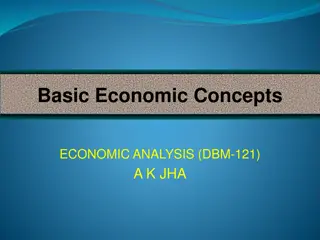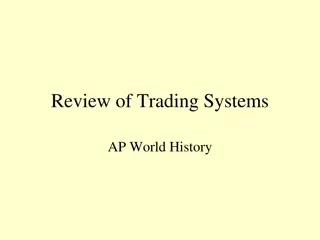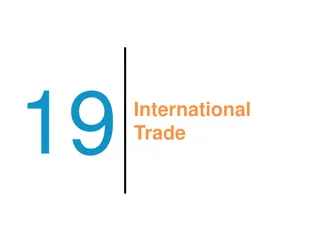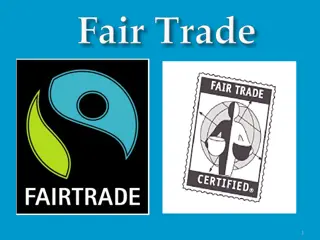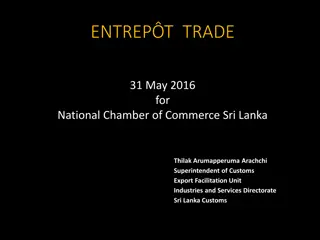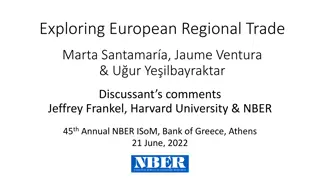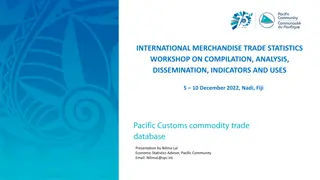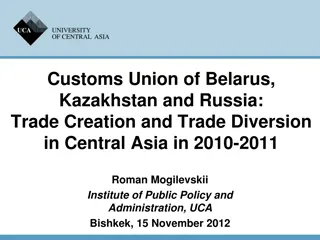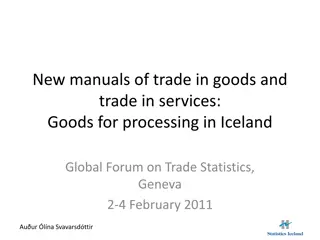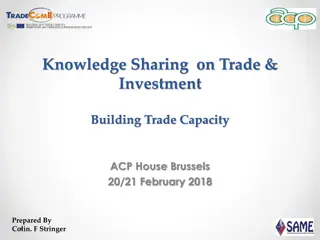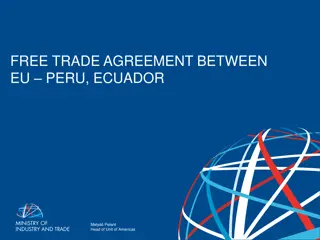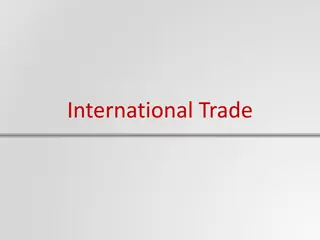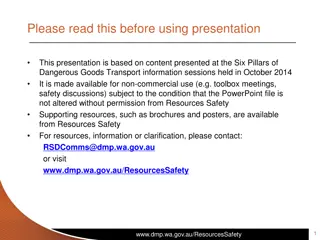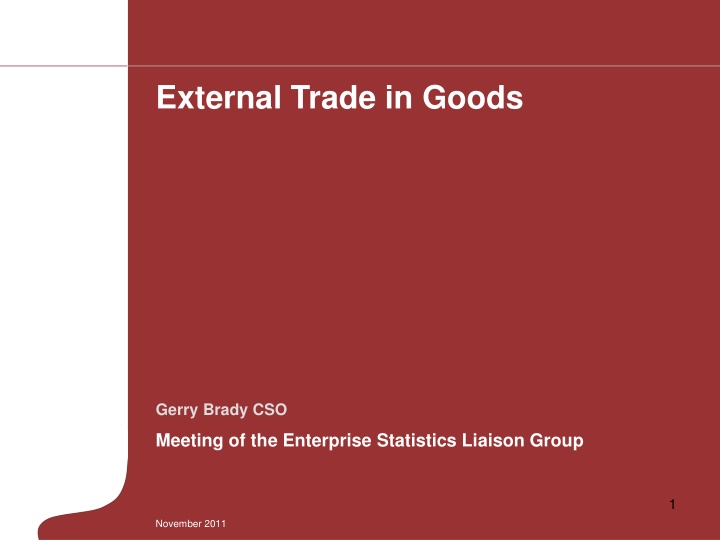
Insights into External Trade Statistics and Data Collection
Explore the origin and regulations of external trade statistics, including the establishment of the Intrastat system. Learn about the thresholds for reporting trade values and data collection methods by the VIMA Office of the Revenue Commissioners. Stay informed on the complexities of trade data management and the importance of accurate statistical reporting.
Download Presentation

Please find below an Image/Link to download the presentation.
The content on the website is provided AS IS for your information and personal use only. It may not be sold, licensed, or shared on other websites without obtaining consent from the author. If you encounter any issues during the download, it is possible that the publisher has removed the file from their server.
You are allowed to download the files provided on this website for personal or commercial use, subject to the condition that they are used lawfully. All files are the property of their respective owners.
The content on the website is provided AS IS for your information and personal use only. It may not be sold, licensed, or shared on other websites without obtaining consent from the author.
E N D
Presentation Transcript
External Trade in Goods Gerry Brady CSO Meeting of the Enterprise Statistics Liaison Group 1 November 2011
Enterprise Statistics Liaison Group Origin of External Trade statistics Customs declarations are used for statistical purposes as the basic data source for trade with Non-EU Member States. They provide detailed information on exports and imports of goods with a product and geographical breakdown. The advent of the Single Market on 1 January 1993, with its removal of customs formalities between Member States required the establishment of a new data collections system called Intrastat. 2 November 2011
Enterprise Statistics Liaison Group Basic Regulations Extrastat Regulation (EC) No 471/2009 of the European Parliament and of the Council of 6 May 2009 on Community statistics relating to external trade with non-member countries Intrastat Regulation (EC) No 638/2004 of the European Parliament and of the Council Amended by : Regulation (EC) No 222/2009 3 November 2011
Enterprise Statistics Liaison Group Intrastat Intrastat system was created seeking two major goals: to satisfy user needs by providing the same statistical information on trade as before and at the same time to reduce administrative burden on traders while providing statistical data. Intrastat is closely linked with the VAT system relating to intra- Community trade in order to ensure completeness and quality of the statistical data. 4 November 2011
Enterprise Statistics Liaison Group Intrastat Thresholds Member States have to ensure that at least 97% of dispatches and 95% of arrivals of trade value to/from the Member States is covered Traders whose imports from EU countries exceeded 191,000 in 2010 must make a detailed import return each month in 2011. Traders whose exports from EU countries exceeded 635,000 in 2010 must make a detailed export return each month in 2011. 5 November 2011
Enterprise Statistics Liaison Group Data Collection The VIMA Office of the Revenue Commisioners collects both the intra-EU (survey) and extra-EU trade (daily tranfers from Customs) data. Before 2011, the CSO surveyed companies operating in the Shannon Free Zone. The CSO survey did not collect full product or partner country detail. Since 2011, VIMA has collected these transactions at full product and partner country detail. Parcel post Parcel post subject to Customs processing and a figure for this is received from VIMA. The CSO estimates the value of Non-EU goods that are imported or exported by parcel post and not recorded by Customs. 6 November 2011
Enterprise Statistics Liaison Group Reporting Deadlines National requirement Traders must furnish the data to VIMA not later than the 10th working day after the reference month. EU Requirements Member States must provide Eurostat with intra- and extra-EU aggregated statistics within 40 days after the reference month. For detailed statistics the deadlines are 42 days for extra-EU statistics and 70 days for intra-EU statistics. 7 November 2011
Enterprise Statistics Liaison Group 2012 Data Collection Changes The required date for traders to make a return will be extended from the 10thworking day to not later than 23 days after the reference month. This will align the return date with VIES and VAT facilitating traders to make better quality returns. Traders will be obliged to make their returns electronically using ROS (paper returns are expensive to process and were subject to a high level of error in terms of human transposition). CN unit value checks will be incorporated into the ROS upload allowing traders to verify unit values based on values set by the CSO. 8 November 2011
Enterprise Statistics Liaison Group VAT Returns All VAT traders are required to record the value of goods imported from and exported to other EU Member States. These returns are used for: estimating the value for traders below the Intrastat thresholds estimating for non-response compiling a register of Traders Identifying traders required to make detailed returns 9 November 2011
Enterprise Statistics Liaison Group Intrastat Response Burden EU and national strategy aims to reduce the administrative burden on businesses caused by the requirements of public administration. The statistical burden accounts for a relatively small part of the total administrative burden in the Member States. The Intrastat reporting burden forms a significant proportion of all statistical reporting obligations on businesses. 10 November 2011
EnterpriseStatistics Liaison Group Exclusions Services are included in Balance of Payments Customised software refers to software that is developed to order for a particular client and made to special requirements Software supplied which does not involve a physical exchange of goods Software downloaded from the Internet. 11 November 2011
Enterprise Statistics Liaison Group Information collected Month VAT number CN product code (8 digits) SITC code (5 digits, derived from CN) Invoice value Statistical value Net mass (kg) Supplementary unit (number/quantity) EU / Non-EU Partner country Country of consignment Delivery terms (CIF, FOB etc.) Nature of transaction (sale, purchase, returns, repairs etc.) Mode of transport (Extrastat, sea, air, etc.) Port of entry/exit (Extrastat) Invoice currency (Extrastat) Type (imports/exports) 12 November 2011
Enterprise Statistics Liaison Group VAT Register Variables VAT number ABT company ID ABT group code Revenue activity code Trader name Address VAT return requirements Date company added/cancelled Return under Group VAT number 13 November 2011
Enterprise Statistics Liaison Group Invoice value Invoiced amount is the value of the goods indicated on the invoice. Transport and insurance costs which are part of the contract price should be included. VAT and Excise duties (on alcohol, tobacco and hydrocarbon oils) should be excluded. Currency conversion shall be made if the value is stated in a foreign currency. 14 November 2011
Enterprise Statistics Liaison Group Statistical Value Statistical value, delivery terms and mode of transport are required only from traders with imports of over 5m or exports of over 34m. The statistical value for exports shall be a FOB-type value (free on board) which means the value of the goods as they leave the territory of the Member State reporting the dispatch. The statistical value for imports shall be a CIF-type value (cost, insurance, freight). This means the value of the goods when they enter the territory of the Member State reporting the arrival. 15 November 2011
Enterprise Statistics Liaison Group Number of CN Codes Year Creations Deletions Total Evolution CN Codes 2002 780 654 1434 126 10400 2003 19 15 34 4 10404 2004 273 503 776 -230 10174 2005 97 175 272 -78 10096 2006 486 740 1226 -254 9842 2007 917 1039 1956 -122 9720 2008 75 96 171 -21 9699 2009 127 257 384 -130 9569 2010 180 306 486 -126 9443 2011 132 281 413 -149 9294 2012 907 818 1,725 89 9383 16 November 2011
Enterprise Statistics Liaison Group Data Editing Prior to 2011 VIMA were responsible for a large amount of micro data editing. The CSO provided VIMA with guideline CN unit values to assist in this work. In January 2011 the CSO took over primary responsibility for all editing of the data not validated by the Trader (VIMA still undertake some initial editing e.g. valid CN code etc.). VIMA now focus their queries on the quality of the large traders data and on unusual transactions. They only amend data if the trader provides corrections. Much of the CSO editing is focused on amending the net mass and supplementary values in cases where the unit values are extremely high or low. 17 November 2011
Enterprise Statistics Liaison Group Volume and Price Indices Calculation methodology The monthly price (unit value) index measures monthly price trends relative to the annual levels in the preceding year using value weights relating to that year s trade (Laspeyres index). The annual index is compiled using value weights for both the current and previous year (Fisher index) to allow for changes in the structure of external trade. Difficulties Wide variations in unit prices both within a CN and within related CNs. 18 November 2011
Enterprise Statistics Liaison Group Consistency of Goods Data across CSO A Large Cases Unit was established in 2010 to ensure that the various CSO Divisions used consistent data for the very large enterprises. There are quarterly meetings held and some adjustments are made to the returns from VIMA for a small number of very large enterprises to align the data with Balance of Payments data for trade in goods. 19 November 2011
Enterprise Statistics Liaison Group Monthly Trade release Issues 7 weeks after reference month Value of trade Volume and Price indices Terms of trade Seasonally adjusted series Value by SITC division Value by partner country Value by partner country and SITC Section 20 November 2011
Enterprise Statistics Liaison Group Detailed monthly Trade publication Table 1 Summary of trade, and Indices Table 2 Seasonally adjusted series, and Indices Table 3 Imports by Main use, and % Table 4 Imports by Main use and Area of origin, Table 5 Exports by Industrial origin, and % Table 6 Exports by Industrial origin & Destination, Table 7 Trade by Area, Table 8 Trade by Area: % distribution Table 9 Trade by country, Table 10 Trade by SITC Section and Division, Table 11 Trade by Division and Country, Table 12 Trade by Country and Division, Table 13 Imports by 5-digit SITC & Country, & Tonnes Table 14 Exports by 5-digit SITC & Country, & Tonnes 21 November 2011
Enterprise Statistics Liaison Group Trade Helpdesk and Statbank The CSO data bank contains a large amount of trade data, http://www.cso.ie/px/pxeirestat/Database/eirestat/Trade/Trade_statbank.asp?SP=Trade&Planguage=0 The Trade Helpdesk provides a special queries facility. 22 November 2011
Enterprise Statistics Liaison Group Goods and Services in 2010 Value of Trade in Goods and Services 2010 billion Type Exports Imports Goods 89.2b 45.8b Services 73.8b 80.9b 23 November 2011
Enterprise Statistics Liaison Group Total Goods Trade 2010 Value of Total Goods Trade 2010 VAT number value size class Class Vat Exports Vat Imports numbers 17,384 numbers 47,332 < 100,000 196m 583m 2,783 7,187 < 1m 872m 2,285m 1,378 2,886 < 100m 14,399m 21,979m 116 64 100m + 72,765m 19,590m Total 21,661 57,469 88,232m 44,437m 24 November 2011
Enterprise Statistics Liaison Group Intra-EU Goods Trade 2010 Value of Intra-EU Goods Trade 2010 (excludes estimates) VAT number value size class Exports Imports Class Vat Vat m m numbers numbers 101 875 < 100,000 4m 41m 563 3,758 < 1m 290m 1,531m 1,169 2,405 < 100m 12,534m 17,331m 72 37 100m + 36,999m 9,509m Total 1,905 7,075 49,827m 28,412m 25 November 2011
Enterprise Statistics Liaison Group Exports 2010: VAT numbers and Value Class Vat Exports million 20,761 Value per trader 11.6m numbers 1,796 USA Great Britain 1,611 11,977 7.4m Germany France Switzerland Spain Netherlands Italy China 835 798 800 590 756 606 5,948 4,391 3,557 3,306 3,015 2,626 2,494 7.1m 5.5m 4.4m 5.6m 4.0m 4.3m 2.5m 1,004 26 November 2011
Enterprise Statistics Liaison Group Exports of Goods to Poland and China 2004-2010 Year Vat Exports Vat Exports numbers numbers Poland 504 China 560 2004 279m 639m 2005 345 593 280m 910m 2006 370 599 400m 875m 2007 396 574 567m 1,320m 2008 393 494 723m 1,609m 2009 411 624 601m 1,633m 2010 415 748 558m 1,672m 27 November 2011
Enterprise Statistics Liaison Group Non-EU Trade: Currency used in Trade with USA Flow Imports Currency Euro Dollar Missing 2010 16% 81% 3% 2011 (to Sep) 9% 88% 3% Exports Euro Dollar Missing 12% 88% 0% 6% 94% 1% 28 November 2011
Enterprise Statistics Liaison Group Linking Business Statistics to trade Business data can be linked to External Trade data via the VAT number. The CSO Business Register contains a companies enterprise number and VAT number. Larger companies would be surveyed in the Census of Industrial production. This survey collects data on employment, turnover, etc. 29 November 2011
Enterprise Statistics Liaison Group Dissemination plans More web based dissemination Allow users to make their own tables Incorporate a business view of the data Thematic reports (markets, products etc.) Invoice currency Business view Nationality of traders Number of traders by market and commodity Product diversification among traders Linkage to PRODCOM and Census of Industrial Production Linkage with Service Exports and Imports 30 November 2011




